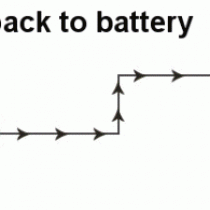Blog - EVBIKE
How is the support for regenerative braking in EVBike kits?
The regenerative braking (called also recuperative braking, or energy recycling, etc) means that part of the kinetic energy is returned back to the battery instead of changing into heat at the brakes. Technically there are several methods of regenerative braking:
- Manual braking. When pressing the brake lever softly, the contact button is pressed and the motor controller starts regenerative braking even before the manual brakes start operation.
- Speed braking. After reaching a certain speed, the controller starts to slow down the speed by regenerative braking.
In order to have the regenerative braking, three requirements must be matched.
First: the electric drive must support the regenerative braking. This means only the EVBike kits with motor in the wheel (EVBike WheelKit) support the regenerative braking. For example with the EVBike Central kit the braking by the motor is not technically possible, because the motor is only used when pedaling and there is no transfer of the energy from the wheel back to the central motor. It is nonsense to ask about the regenerative braking for the EVBike Central kit.
Additionally the power rating of the motor in the wheel must correspond with the braking power. For the small size motors with nominal power of 250 Watts the effective braking power is some 180Watts. This value is very small and this rating will not give much energy back to the battery. Simply said, braking power of only 200 Watts is for no practical use.
Second: the motor controller. In order to recuperate the energy the controller must support this function. This means the electronics of the controller must be able to reverse the current in the opposite direction to charge the extra energy from the motor back to the battery. Most controllers do not support this function. This function requires additional electronics and increases the cost of the controller.
Third: the battery must support regenerative braking. In order to support the regenerative braking the battery must be able to absorb the peaks of the energy. This means the battery and the battery protection electronics must support high speed charging. In order to brake effectively, the motor, the controller and the battery should support high power rating of 1000 Watts and more. For a 36V battery, it means the controller and the battery charging circuits must be able to work with 30Amp charging currents.
For example the EVBike EVBat batteries (e.g. EVBAT36V13A, EVBAT36V9A, EVBAT48V9A) are based on the Li-on technology (the cells made by Samsung). These batteries DO NOT support high speed charging. The maximal charging is given at 0.2C (2 Amps for the 10AH battery). This means this battery supports only 70Watts (!) of charging power. This type of battery cannot be used for regenerative braking. If users try to use this battery for regenerative braking the smart BMS inside the battery will record this situation and the warranty for the battery is void. If you try to use the regenerative braking for these Li-on technology batteries, you will destroy this battery soon. Note that this battery technology does not support high number of cycles – see here: only 300 cycles supported.
Only LiFePO4 and the latest LTO technology supports high speed charging. For example the LIFePO4 supports up to 3C charging. The LTO support up to 6C charging. This means you can charge these batteries quickly. This kind of battery is a specialty product, much more expensive than the ordinary EVBike batteries with the “cheap Samsung technology”. For customers who require the regenerative braking we suggest to assemble the battery pack of their own.
Summary: most electric bikes do not support the regenerative braking. Some companies fool the customers with support of regenerative braking, but in fact offer some kind of limited braking of few hundred watts. In order to have the full recuperative braking, the motor, the controller and the battery must support at least 1000W of braking power peaks. This technology will not be cheap and after all the return of the braking power is still only part of the energy. The regenerative braking on electric bikes is economic nonsense.
If you want to save costs on your EVBike kit, forget about the regenerative braking.

 English
English Česká republika
Česká republika Germany
Germany France
France España
España Italia
Italia Sverige
Sverige Polski
Polski Nederland
Nederland










